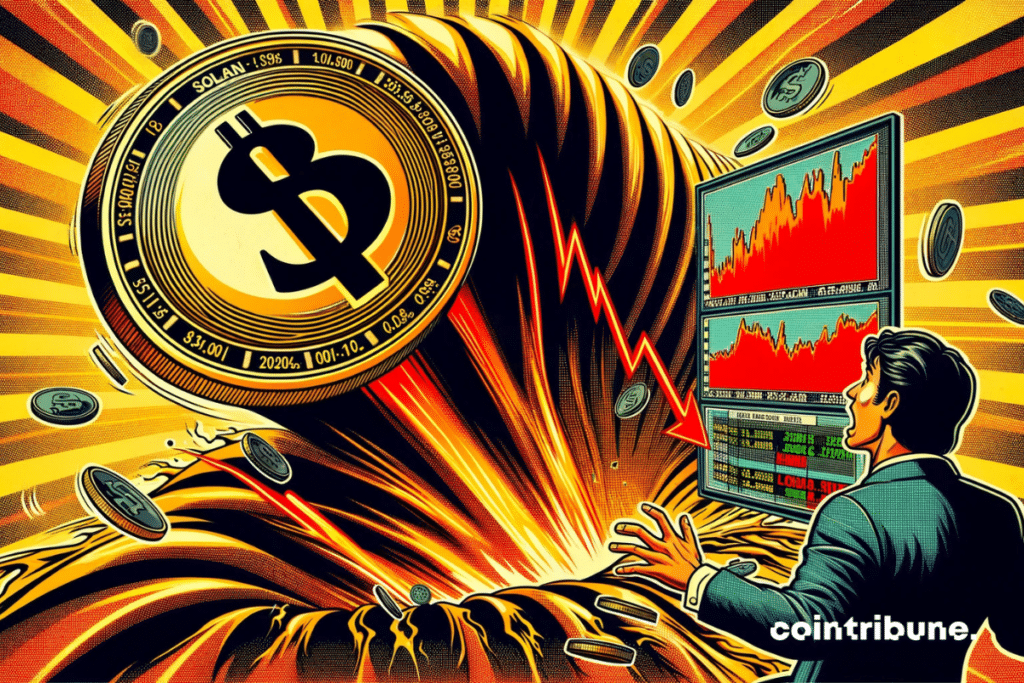Solana Plunges 41%: SOL Under Pressure
The crypto market is going through a new phase of turbulence. Solana (SOL) has dropped by 41% in just a few weeks. This decline is not merely a market correction: it highlights structural weaknesses and a high dependence on certain speculative trends.

A network under pressure, impacted by the volatility of cryptos
At the beginning of February 2025, Solana users reported a degradation of performance on the network.
Transactions, usually nearly instantaneous, began to experience unusual delays. Some holders of the SOL crypto even encountered repeated failures during their exchanges on decentralized platforms (DEX).
This slowdown is largely explained by intense activity related to memecoins, those highly speculative tokens inspired by viral trends.
Solana, despite its ambitious positioning, remains one of the favorite playgrounds for these cryptos. Projects like LIBRA, once backed by public figures, attracted colossal sums before collapsing by 95%, leading to a chain of massive liquidations. In the span of 24 hours, 227 million dollars in positions were liquidated, amplifying the pressure on the SOL crypto.
The issue is not limited to speculation: the architecture of Solana, although performant under normal circumstances, shows its limits in the face of excessive demand. An excessive centralization of validators and recurrent congestion raise questions about the network’s ability to absorb large-scale adoption.
Bitcoin as a refuge
While the Sol crypto wavers, Bitcoin maintains its place as a safe haven. Its dominance reaches 61%, an unprecedented level since 2021, signaling that investors are turning to assets perceived as more resilient.
Even Bitcoin ETFs, despite experiencing net exits of 516 million dollars, are weathering the storm better than the sharply declining altcoins.
This context underscores an increasingly marked fracture within the crypto market. On one side are established projects like Bitcoin and Ethereum, which are gradually becoming embedded in concrete uses. On the other side are blockchains like Solana, which, despite their technological advancements, still largely depend on speculative dynamics.
Moreover, regulatory oversight remains a factor to watch. The SEC recently concluded its investigations into Uniswap and Coinbase, a strategy that could signal a desire to foster a more stable framework rather than stifle innovation.
However, Solana, due to its association with certain major incidents (including a recent hack of 1.5 billion dollars on Bybit), could remain under the regulators’ spotlight.
While the current drop of Solana is concerning, it does not signify the end of the project. To regain market confidence, the network will need to strengthen its robustness, further decentralize its validators, and attract developers beyond just memecoins. The ecosystem must prove its capacity to support more varied and sustainable activities, particularly in decentralized finance (DeFi).
Maximize your Cointribune experience with our "Read to Earn" program! For every article you read, earn points and access exclusive rewards. Sign up now and start earning benefits.

Fascinated by Bitcoin since 2017, Evariste has continuously researched the subject. While his initial interest was in trading, he now actively seeks to understand all advances centered on cryptocurrencies. As an editor, he strives to consistently deliver high-quality work that reflects the state of the sector as a whole.
The views, thoughts, and opinions expressed in this article belong solely to the author, and should not be taken as investment advice. Do your own research before taking any investment decisions.